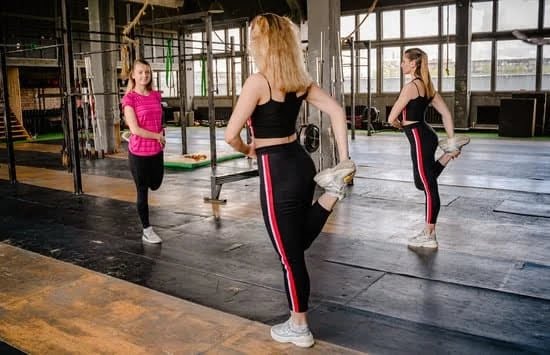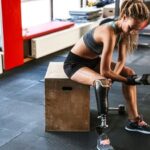Have you ever experienced the frustration of your jeans fitting tighter after a leg workout? Many people encounter this common phenomenon, wondering why their clothing suddenly feels more snug than before hitting the gym. Understanding the reasons behind this can provide insight into how our bodies respond to physical activity and the changes that occur within our muscles post-exercise.
One key factor in why jeans fit tighter after a leg workout is the increased blood flow to the muscles during physical activity. This enhanced circulation helps deliver essential nutrients and oxygen to the legs, but it can also result in temporary swelling of the muscle tissue. As a result, the thighs and calves may feel larger or more voluminous, causing a tight sensation when trying to put on clothing like jeans.
In addition to blood flow, water retention plays a significant role in this phenomenon. When we exercise, especially engaging in activities like squats and lunges that target the leg muscles, our bodies can retain water as part of the repair and recovery process. This retention can lead to bloating and temporary tightness in clothing as the muscles hold onto fluid. Understanding these physiological responses can help individuals better navigate post-workout discomfort and clothing fit issues.
Understanding the Mechanics
After a rigorous leg workout, you might have noticed that your jeans suddenly feel tighter. This common phenomenon can be attributed to the mechanics of how our muscles react to intense exercise.
When we engage in activities like squats, lunges, or other lower body exercises, the muscles in our legs and thighs experience micro-tears that result in inflammation and swelling. This temporary increase in muscle size can impact the way our clothing fits, causing jeans to feel snug or constricting.
One key factor contributing to why jeans fit tighter after a leg workout is the increased blood flow to the leg muscles during exercise. As we work out, our body directs more blood to the muscles being used to provide them with oxygen and nutrients for optimal functioning.
This heightened circulation can lead to temporary swelling in the legs as a result of fluid retention. The combination of inflamed muscles and excess fluid can make it challenging to slide into your favorite pair of jeans post-workout.
In addition to increased blood flow, water retention plays a significant role in the tightness experienced in clothing after a leg workout. The body tends to hold onto water during and after strenuous physical activity as part of its natural response to repair damaged tissues and regulate temperature.
This retained water can cause temporary bloating and tightness in clothing, making it seem like your jeans have inexplicably shrunk overnight. Understanding these physiological processes can help you navigate through post-workout discomfort and ensure that your choice of attire remains comfortable throughout the day.
| Factor | Impact |
|---|---|
| Increased Blood Flow | Temporary swelling due to heightened circulation |
| Water Retention | Body holds on to water for tissue repair post-workout |
Increased Blood Flow
After a rigorous leg workout, it is not uncommon to notice that your jeans feel tighter than usual. One of the reasons behind this phenomenon is the increased blood flow to the leg muscles during exercise. When you engage in activities like squats, lunges, or other lower body exercises, your muscles require more oxygen and nutrients to function optimally. As a result, your body increases blood flow to these areas to meet the demand.
The keyword “why jeans fit tighter after leg workout” can be explained by this process of increased blood flow. The additional circulation to the leg muscles can cause temporary swelling, known as muscle pump.
This swelling is a natural response to the stress placed on the muscles during a workout and is part of the repair and recovery process. While this swelling is beneficial for muscle growth and strength development, it can lead to tightness in clothing like jeans due to the increased volume in the leg area.
It’s essential to understand that this temporary swelling and tightness in jeans are normal after a leg workout and should subside within a few hours to a day. In some cases, staying hydrated and engaging in light stretching post-workout can help alleviate this tight feeling faster.
Additionally, wearing compression clothing or opting for looser-fitting bottoms can provide more comfort during this recovery period. By being aware of how increased blood flow affects clothing fit after exercise, you can better manage any discomfort and continue progressing in your fitness journey.
| Increased Blood Flow Effects | Recommendations |
|---|---|
| Temporary swelling in leg muscles | Stay hydrated and stretch post-workout |
| Tightness in clothing like jeans | Wear compression clothing or looser bottoms |
Water Retention
To better understand why jeans fit tighter after a leg workout, it’s important to recognize that water retention plays a significant role in this scenario. When you work out, particularly focusing on exercises that target the lower body, your body may hold onto water as part of its natural response to physical stress.
This can cause temporary bloating or puffiness in the legs, making it challenging to comfortably wear tight-fitting clothing like jeans. Additionally, the combination of increased blood flow and fluid retention can create a feeling of tightness or discomfort in your legs post-workout.
Here are some ways water retention during and after workouts can lead to tight-fitting jeans:
- Increased blood flow from exercise causes fluid to accumulate in the muscles.
- Hormonal changes during physical activity can impact fluid balance in the body.
- Intense leg workouts can create micro-tears in muscle fibers, leading to inflammation and temporary swelling.
Managing water retention post-leg workout can help alleviate tightness in clothing like jeans. Ways you can reduce this issue include staying hydrated throughout your exercise routine, incorporating cooling down stretches or movements into your post-workout routine, and consuming foods with diuretic properties that promote fluid balance in the body. By understanding how water retention affects clothing fit after exercise, you can make informed choices to maintain comfort and mobility during recovery periods.
Impact of Squats and Lunges
Squats and lunges are two of the most effective leg exercises that can heavily impact the muscles in the lower body. These types of exercises target various muscle groups such as the quadriceps, hamstrings, glutes, and calves, leading to strength gains and muscle growth. However, it is not uncommon for individuals to experience a peculiar phenomenon where their jeans fit tighter after performing squats and lunges during a workout session.
Engagement of Multiple Muscles
During squats and lunges, multiple muscles in the legs are engaged simultaneously to support movement and stabilize the body. The intensity of these exercises often leads to micro-tears in muscle fibers which then repair and grow stronger over time. As a result, this process can cause temporary inflammation or swelling within the muscles due to increased blood flow and fluid retention. This swelling can lead to a feeling of tightness in clothing, especially around the thighs and calves.
Increased Blood Flow
Another reason why jeans may fit tighter after a leg workout involving squats and lunges is the increased blood flow to working muscles. As blood rushes to deliver oxygen and nutrients to the muscles being exercised, it can also cause them to temporarily swell or appear larger than usual. This combination of swelling and heightened blood circulation can contribute to a sensation of tightness when wearing clothing like jeans that may have less give or stretch compared to activewear.
Reparation Time
After a strenuous leg workout, it is common for individuals to experience a phenomenon where their jeans fit tighter than usual. Understanding how long it takes for this temporary tightness to subside can help individuals better navigate post-exercise discomfort and clothing fit issues. The reparation time varies from person to person depending on factors such as the intensity of the workout, individual muscle recovery time, and overall hydration levels.
Individual Variations
The length of time it takes for the swelling and tightness in the legs to subside post-workout can vary significantly among individuals. Factors such as fitness level, frequency of workouts, and overall health can impact how quickly one’s muscles recover from exercise-induced stress. Some people may notice their jeans fitting snugly for just a few hours after a workout, while others might experience tightness for a day or more.
Muscle Recovery Time
One of the key determinants of how long it takes for tight-fitting jeans to return to normal post-leg workout is the body’s natural muscle recovery process. After an intense workout, the muscles in the legs undergo microscopic damage that triggers inflammation and repair mechanisms within the body.
This repair process can lead to temporary swelling and tightness in the affected muscles, which in turn can affect clothing fit. Proper rest, hydration, and nutrition play crucial roles in supporting muscle recovery and reducing post-workout discomfort.
Hydration Levels
Another important factor that influences how long it takes for jeans to fit normally after a leg workout is hydration levels. Dehydration can exacerbate inflammation and delay muscle recovery, leading to prolonged tightness in the legs.
Ensuring adequate hydration before, during, and after exercise can help support blood flow to the muscles, flush out toxins that contribute to swelling, and promote overall recovery. Monitoring water intake and maintaining proper hydration levels are essential for minimizing post-workout tightness and discomfort in clothing fit.
Tips for Managing
After a strenuous leg workout, it is not uncommon for your jeans to feel tighter than usual. This phenomenon can be attributed to various factors related to the effects of exercise on your muscles and body. Understanding why jeans fit tighter after a leg workout can help you manage this temporary discomfort effectively.
To alleviate the tightness in your jeans post-leg workout, here are some practical tips you can follow:
- Wearing Compression Clothing: Opting for compression leggings or shorts can help support your muscles and reduce swelling after a workout. Compression clothing can also improve blood circulation and aid in faster recovery.
- Choosing Looser-Fitting Bottoms: Instead of squeezing into your skinny jeans right after a leg session, consider wearing looser pants or athleisure wear to give your legs some breathing room. Look for bottoms with stretchy fabric that accommodates any temporary swelling.
- Staying Hydrated: Drinking plenty of water before, during, and after your workout helps flush out excess fluids retained by the body during exercise. Proper hydration can aid in reducing bloating and tightness in clothing like jeans.
Conclusion
In conclusion, the phenomenon of jeans fitting tighter after a leg workout can be attributed to various factors such as muscle swelling, increased blood flow, and water retention. Understanding the mechanics behind this temporary change in clothing fit is crucial for individuals who regularly engage in leg-focused exercises like squats and lunges.
As the muscles in the legs and thighs work hard during a workout, they may experience inflammation and swelling, leading to a feeling of tightness when wearing certain clothing items like jeans.
While it may be frustrating to struggle with tight-fitting jeans post-leg workout, it is essential to remember that this is a normal response of the body to physical activity. The reparation time for the swelling and tightness typically varies from individual to individual but can usually subside within a few hours to a day.
During this period, it may be helpful to opt for more breathable and comfortable clothing options or embrace compression garments that can alleviate some of the discomfort caused by the temporary changes in your body’s physiology.
Overall, being mindful of how your body responds to exercise and learning how to manage these temporary changes can not only enhance your comfort but also improve your overall well-being. By following practical tips like choosing looser-fitting bottoms or incorporating recovery strategies into your post-workout routine, you can navigate through the occasional inconvenience of tight-fitting jeans with ease.
Remember, listening to your body’s signals and adapting accordingly is key to maintaining a healthy balance between fitness goals and personal comfort.
Frequently Asked Questions
Why Are My Pants Tighter After Leg Day?
After a leg day workout, your muscles will be swollen due to the inflammation caused by the micro-tears in the muscle fibers. This swelling can make your pants feel tighter and uncomfortable.
Why Are My Jeans Tight After Working Out?
Working out can lead to temporary muscle inflammation and swelling, especially in the legs and glutes. This increased muscle size can cause your jeans to feel tighter than usual until the inflammation subsides.
Why Are My Jeans So Tight All of a Sudden?
Your jeans might suddenly feel tight due to factors like weight gain, bloating, or changes in body composition. It’s also possible that the fabric has shrunk slightly in the wash or you’ve unknowingly gained some weight.

Passionate about providing useful information to anyone with an interest in the field of Personal Training, I strive to pass on to our readers quality information and to answer any questions about Personal Trainers, the work they do and how to become one.





